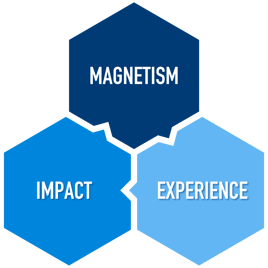How to Integrate DEI Into Your Employee Success Strategies
Your business’ success depends on your employees’ success. But what exactly does that look like? And how can you drive success for your employees?
Employee success captures the holistic experience employees have at work—from the time they are hired to the time they leave. Broadly speaking, it is about creating an environment where everyone can be successful—ultimately leading to higher engagement, increased productivity, and higher retention across the organization.
Building a culture of employee success relies on three key components:
|
 |
But investing in these initiatives takes time, effort, and commitment. And there are a number of challenges facing workplaces today that threaten long-term employee success—and, by extension—organizational success.
From a growing trust gap between employees and leadership to high turnover rates, many organizations are struggling to move the needle on employee success in one or more of these key pillars.
These challenges indicate an underlying disconnect between what employees want and need and what organizations are delivering. To bridge those gaps, employers need to better understand their employees. But there is no “one set” of needs—each employee is different. That’s where diversity, equity, and inclusion (DEI) can help.
A DEI lens can help companies dive deeper to identify and understand those differences and help leaders make data-driven decisions about what to offer employees.
Here’s how to do it.
|
Quantum Workplace and The Kaleidoscope Group partner to provide our clients access to enhanced employee listening, performance feedback, workforce analytics, and deep subject matter expertise in Diversity, Equity, and Inclusion (DEI). Quantum Workplace’s employee success platform empowers organizations to understand and improve employee experience, inspire employee impact, and create a magnetic culture. The Kaleidoscope Group is a full-service DEI consulting firm with 30 years of proven experience guiding clients through organizational transformation through tangible DEI actions. |
How DEI Impacts and Enables Employee Success
Defining and measuring employee success will look different for different companies—and for different employees. Success will depend on what you and your employees are trying to achieve, what environment they are working in, and their needs and expectations at your workplace.
In other words, there is no one-size-fits-all when it comes to employee success.
That’s why DEI is a critical component of any employee success strategy. DEI helps you understand your employees so you can support their success in a way that takes multiple perspectives into account and approaches every initiative with greater inclusion and equity across the board. When employees feel seen, heard, and valued, they are more likely to have a positive experience and connect with your organization in a meaningful way.
Below we’ll explore the connection between DEI and employee success for each key pillar, and how you can integrate DEI into your employee success strategies.
DEI and Employee Experience
Creating an engaging employee experience is a key component of creating a culture of employee success. Organizations must work to understand, validate and improve upon what matters most to employees through employee listening.
But to get good data, you have to ask the right questions and analyze it in a meaningful way. And part of that requires recognizing the diversity that exists within your organization—not only in visible characteristics like age, gender, race, and ethnicity but also in opinions, experience, working styles, and more.
Breaking down employee feedback and experience data across a variety of demographics is important because not everyone will perceive or experience the workplace in the same way. And employees have varying needs and desires.
Look through a DEI lens to support how you gain understanding of and act on employee experience. This approach helps you recognize and understand
- the diversity of your workplace
- how those differences impact the employee experience
- how you can implement policies, practices, and initiatives that boost belonging and enable their best work
Communicate Your Results and Create Continuous Feedback Loops
Gathering data is important, but don’t stop there. To drive success, you need to communicate the results of your surveys and other listening activities and act on them. No need to share it all, but it’s imperative to let people know their voice mattered. You heard them, and here is what you will do about it.
This is an essential part of validating your employees and helping them feel included. Plus, when you actually act on feedback, you can prevent survey fatigue, which builds trust in leadership and helps employees be more willing to share feedback.
Pro Tip: Taking the time to understand different perspectives can be uncomfortable. Recognize you may need help at first. Getting guidance from a trained DEI expert on how to analyze different demographic groups—and what it all means—is a good idea if this is a new approach for you.
DEI and Employee Impact
Cultivating employee impact is about inspiring teams and individuals to perform at their best by making sure they understand the role they play in the company’s success. This means using modern and engaging approaches to performance management that are centered around growth and development, feedback, clear expectations, etc.
Recognition
Fifty-percent of employees want more recognition. Yet only 37% of employee actually get recognition monthly or weekly. This can have a significant impact on your employee engagement and experience. People want to know that if they contribute to success, they’ll get recognized for it.
And while we like to think our workplaces are meritocracies, data indicates otherwise. That is why it is important to track recognition and rewards by key demographic groups to determine whether there are great disparities. This will not clarify the reasons for the differences, but can provide better perspective on whether employee perceptions align with actual outcomes.
Applying a DEI lens to your success strategies can help you uncover these hidden biases, perceptions, and impacts.
Performance Evaluations
Similarly, another important measure of employee impact is job performance evaluation. Consider:
- Are all employees receiving performance feedback?
- Is the review process standardized to support equitable outcomes?
Equity here matters. Everyone wants assurance that if they contribute, their performance will be evaluated fairly and they will get credit for their work, which in turn will get recognized.
But this isn’t always happening. Sometimes it’s perception. Sometimes it’s reality. Measurement helps differentiate between the two.
For example, some managers may struggle to give difficult feedback, particularly to individuals who are different from themselves. Out of discomfort, they may avoid certain topics and valuable feedback to help the individual improve. These employees then suffer inequitable outcomes because they didn't get the feedback they needed to advance.
On the other hand, employees the manager 'feels more comfortable around' will get better feedback—and the resulting career advantage. This is why bias and cultural competency training can be so valuable to managers, to increase their awareness of the issues and give them skills needed to lead inclusively. A DEI program can also uncover employee perceptions about feedback and recognition to pinpoint where your efforts can improve.
Pro Tip: Breaking out perception data by key demographics can help pinpoint who may feel the work environment is not fair. And analysis of data such as performance review aggregate scores, promotions, pay increases and bonuses, among others, by demographics can help shed some light on what’s actually happening. While this analysis cannot tell you the cause of those disparities, it can provide direction on where to investigate further, to help avoid unintended outcomes.
DEI and Organizational Magnetism
Talent attraction and talent retention are the two pillars of organizational magnetism.
Yet, many organizations are struggling to do both. Today, roughly 60% of disengaged employees—and only 23% of engaged employees—would leave their company for a better culture. This tells us that employee success and engagement are essential to building a magnetic culture.
But what does a magnetic culture look like for your organization?
You need to make sure you are taking differing employee needs and desires into account. Integrating DEI into your success strategy can help you accurately identify and build a magnetic culture.
For example, you can design an exit survey to gather feedback on why employees are leaving and what might entice them to stay. Then be sure to analyze the data by demographics such as gender or ethnicity to understand if different groups are leaving for different reasons. This data can inform your decision making when considering what actions to take.
While you cannot solve for every issue, approaching this in an inclusive way means elevating your awareness and acting where you can to yield a greater positive impact. For instance, consider a back-to-the-office strategy. You could ask all employees if they want to work onsite or virtually. If 30% say onsite and 70% say virtually, that means there are differing needs, and you could make a case for hybrid.
But what kind of hybrid? A DEI lens can help you analyze even farther. If you break out that same data by gender, ethnicity, or age, you can gain a better understanding of the situation. Out of those 70% who want to work virtually, maybe that includes 90% of your female workers and 80% of your workers ages 30-45. This data can help you determine what model will best for most people (and your business).
Pay Attention to the Cultural Messages You’re Sending
A DEI lens can also uncover elements of your company culture you may not have noticed. Sometimes emphasizing certain cultural elements can unintentionally send a message that this place is not for you.
For example, highly gendered language like "bro-speak" (e.g., language promoting an aggressive, beer-drinking, foosball-oriented culture) can inadvertently exclude people who don’t share similar interests or who communicate or socialize differently. If leaders aren’t aware of this, they may end up further promoting that exclusionary culture—which can make employees feel the need to conform to fit in. This undermines feelings of belonging and inclusion, which can impact employee satisfaction, performance, and their perceptions of fairness in the workplace.Employee Success Depends on a Long-Term DEI Approach
When it comes to employee success strategies, DEI is a must have. Because success is specific to the organization and the unique and diverse group of people within it, you need a holistic DEI approach that considers the needs and experiences of every person.
Both employee success and a sustainable DEI plan are essential to business success and deserve thought, intention, and investment from leaders across the organization. Your DEI leaders, your senior leaders, your HR management, and your recruiters should all work together to drive employee success through an integrated DEI approach.
This blog was co-authored by the Quantum Workplace Team and Mary Hunter of Kaleidoscope Group.
About MaryMary founded and built The Kaleidoscope Group’s Assessment and Analytics practice. She has led the development of key DEI analytics solutions and guides clients to greater clarity on what matters most and how to use data-driven insight to ensure DEI efforts positively impact business strategy execution and organizational effectiveness. Prior to joining The Kaleidoscope Group in 2016, Mary spent 13 years in consumer insights, working with primarily Fortune 500 companies to design and execute custom research solutions to guide product and marketing decisions. Mary earned a Master of Arts degree in arts administration from New York University and a Bachelor of Arts degree in art history from the University of Nebraska-Lincoln. She has pivoted more than once in her career, so has first-hand experience with the power of combining transferable skills with an adventurous spirit and boundless curiosity. |

|






